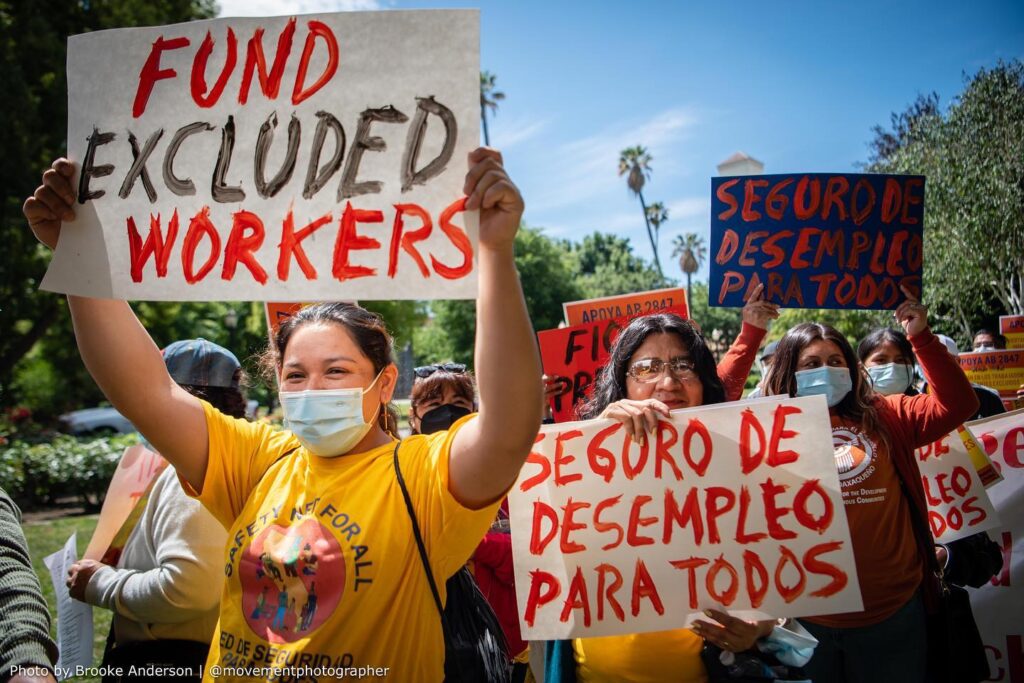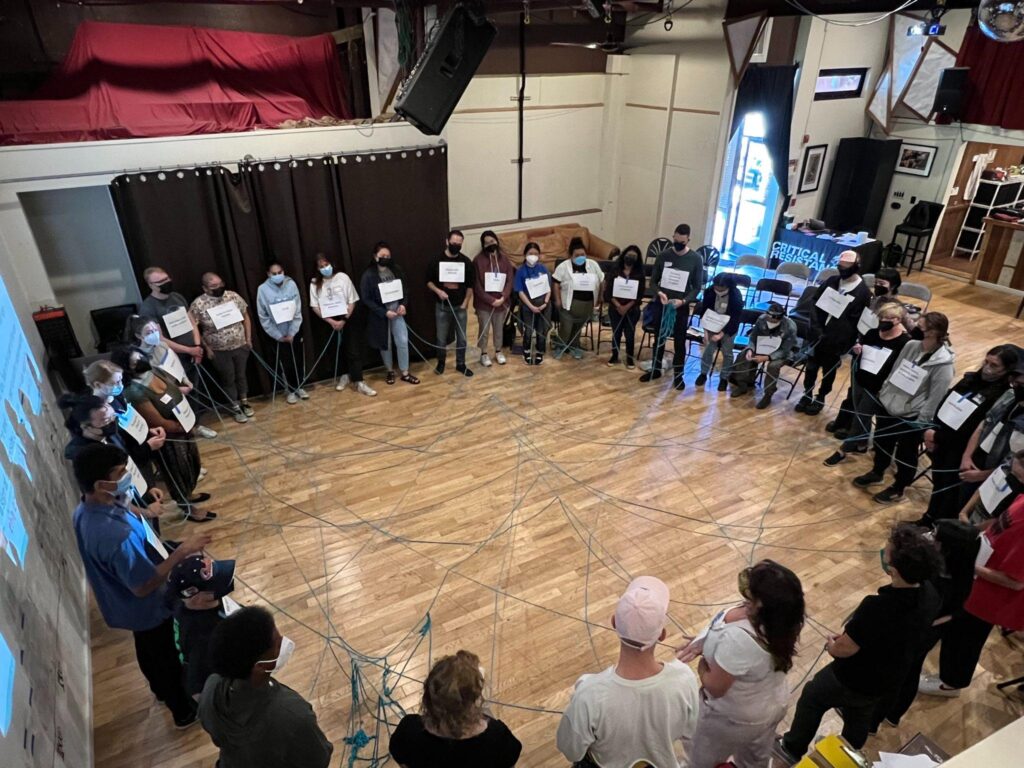This International Workers’ Day, Critical Resistance celebrates recent advances in the labor movement and the necessary growth in ties to the fight for prison industrial complex (PIC) abolition.
We have to look no further than the recent set of bank collapses to see that the capitalist system is in crisis (in this case due to deregulation). The US federal government predictably bailed the banks out – again in glaring contrast its meager and curtailed support for working people under the current recession. We saw a huge transfer of funds from the working class up to the billionaire class beginning during the pitched part of the pandemic – adding fuel to the recession, too. As the internal struggle within the capitalist class to govern neoliberalism heightens, austerity approaches are being put in place that continue to make things more difficult for everyday working people.

The PIC is also being deployed as part of this tightening grip on everyday people. Three years after the 2020 uprisings, we’re seeing some retrenchment of “tough on crime” orientation to the PIC after a media manufactured “crime wave” criminalizes poverty, the National Guard is called to cities like San Francisco to engage in 80’s style “Drug War” tactics, and the continued whittling away of public health and community based services nationally in favor of heightened policing and imprisonment among other threats to worker power. As the PIC continues to use its tried-and-true strategies to destabilize our communities, we see that today’s current workers struggles are directly related to the historical conditions in which the PIC first emerged–the deindustrialization era, and the counter-insurgency & repression of militant labor, anti-colonial, and revolutionary organizing in the late 1960s and early 1970s followed by the introduction of neoliberal economic policies to neutralize radical worker power. It is no surprise, then, that today communities and areas with higher rates of imprisonment are the same areas where union power is lower, because of the barriers placed on people’s ability to gain employment and organize. We know that a central function of the PIC is to manage, warehouse, and exclude millions of workers at the margins, particularly those displaced from the workforce.
On the other hand, even during a period of accelerated union busting and union member attrition as a result of a destabilized workforce, this past year we’ve seen significant organizing victories. There have been significant victories at Starbucks, Amazon and Apple stores. We’ve seen well-publicized strikes of teachers, nurses and railway workers. Even in the past 6 months we’ve witnessed the unionization of staff, graduate assistants and even faculty across campuses, including the recent successful strike of nearly 50,000 academic workers on the campuses of the University of California. In Chicago, local leftist elected former labor organizer Brandon Johnson, who is championed by and in alignment with progressive labor unions. Equity and Transformation (EAT) Chicago, an organization of workers involved in informal economies and led by formerly incarcerated people, contributed to the recent victory by Brandon Johson, while the struggle to support formerly incarcerated people in accessing employment continues. Inside prisons, the Free Alabama movement made up of imprisoned people across the US-South has articulated an approach on the particular conditions around work in US Southern prison that uses prison strikes to demand parole reform and release. There are many examples of abolitionists inside and outside of cages forging cross-sectoral relationships to achieve important victories. However, even with these moves and gains, there remains a strong need to continue drawing connections, in analysis and relationship, between the labor and PIC abolitionist movements.
At Critical Resistance (CR), we strive to draw these connections through our ongoing campaigns and project work. Across prison walls, we’ve been moving our analysis with our imprisoned comrades inside through our most recent issue of The Abolitionist newspaper, Issue 38 on labor struggles and PIC abolition. In honor of May Day, the issue is now available for complete free download on our website, with articles covering a range of topics from reflections on unions and union organizing in a roundtable discussion of different union organizers in the Bay Area, Chicago and Argentina, to the organizing to decriminalize sex work, the recent general strikes in Ecuador and Colombia, challenging the 13th Amendment and prison labor, the rise of “cirminal” background screening coupled with a new employment resource from CR for imprisoned people and former prisoners, and more. Additionally, through our campaign and coalition organizing, CR has been strengthening our partnerships with organized labor as part of our Dignity Not Detention campaign in New York state. Because immigrants are a significant part of the workforce, often representing the most precariously employed workers, we’ve been working to successfully garner support from the Association of Legal Aid Attorneys – UAW 2325 to cancel New York’s contracts with Immigration and Customs Enforcement (ICE).
 As we also know that prisons have a tight grip on our state’s budgets and community resources, we’ve been hard at work bringing organized labor into our Close California Prisons campaign, as well. CR’s Close California (CA) Prisons organizers developed a new workshop as a political education resource for cross-sector movement building, focused on the intersections between labor struggles and the PIC to explore how and why prison closure is an urgent workers’ struggle in CA in hopes of building more worker power to leverage in the fight to close 10 prisons by 2025. Hosting the workshop for the first time just before May Day on April 30 at East Bay Community Space in North Oakland, we were joined by over 30 workers representing different sectors from non-profit and service work to education, healthcare, manufacturing, custodial, and unemployed recently released former imprisoned folks. As CR continues to use “United We Fight: For Workers’ Rights and a World Without Walls” as an outreach, base-building and movement building strategy for prison closure in the Bay Area and beyond, we will continue to fine-tune the curriculum and eventually make it available online for download and wider use. (If you’d like CR to do a workshop on the PIC, abolition, policing, or this new labor workshop with your workplace, union, or organization, request one here).
As we also know that prisons have a tight grip on our state’s budgets and community resources, we’ve been hard at work bringing organized labor into our Close California Prisons campaign, as well. CR’s Close California (CA) Prisons organizers developed a new workshop as a political education resource for cross-sector movement building, focused on the intersections between labor struggles and the PIC to explore how and why prison closure is an urgent workers’ struggle in CA in hopes of building more worker power to leverage in the fight to close 10 prisons by 2025. Hosting the workshop for the first time just before May Day on April 30 at East Bay Community Space in North Oakland, we were joined by over 30 workers representing different sectors from non-profit and service work to education, healthcare, manufacturing, custodial, and unemployed recently released former imprisoned folks. As CR continues to use “United We Fight: For Workers’ Rights and a World Without Walls” as an outreach, base-building and movement building strategy for prison closure in the Bay Area and beyond, we will continue to fine-tune the curriculum and eventually make it available online for download and wider use. (If you’d like CR to do a workshop on the PIC, abolition, policing, or this new labor workshop with your workplace, union, or organization, request one here).
CR understands that those of us who fight for PIC abolition, dignified work, strong labor development and workers’ rights can continue to make significant gains by working together. This International Workers’ Day, we look forward to all that is possible through forging these bonds – a brighter future for all working people.
Onward!
Critical Resistance
